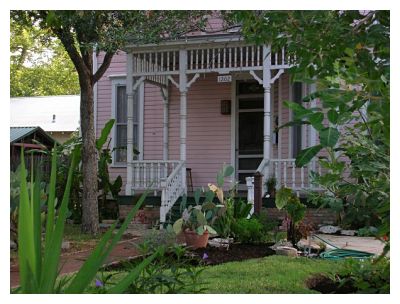Review: In This House Everything Is You by Salvage Vanguard Theater
by Michael Meigs
 No, despite the enigmatic lines of the teaser, this is not a ghost story. It is collaborative imagination of memories tied to the faded upright eloquence of that two-story bed and breakfast residence in lower East Austin now known as the Eponymous Garden.
No, despite the enigmatic lines of the teaser, this is not a ghost story. It is collaborative imagination of memories tied to the faded upright eloquence of that two-story bed and breakfast residence in lower East Austin now known as the Eponymous Garden.
"Eponymous" because the Garden takes its name from the street, Garden Street, and perhaps -- it would seem appropriate -- from that neighborhood in Austin. It's just east of I-35 and a couple of blocks south of César Chávez Street. To find it, you drive east on Chávez and after you cross under the Interstate, at the next traffic light take a right onto Waller Street. The neighborhood has lots of small clapboard houses, of the sort that would have been homes for tradesmen and artisans back in the 'teens of the previous century.
The garden is not very much in evidence in January, but the pictures on the website suggest that the house is engulfed in blossom once better weather arrives. In its weathered pink-and-white elegance, 1202 Garden Street carries a strong flavor of earlier prosperity.
In This House is a collaborative work for which fourteen artists are credited in the single photocopied page of the playbill. Jenny Larson of the Salvage Vanguard and Dustin Wills directed. Others are writers, writer/actors, and actors, both grown ones and child actors.
The residence itself must have suggested the scenes. One imagines company members curled up on sofas under the high ceilings of the front room with its baby grand piano, drinking coffee at the kitchen table, or roaming around the back yard as they wrote, discussed and rehearsed the vignettes. There is a time-line, from about 1905 to the mid 1930's, but it's a tangle, just as memories are a tangle. Successive scenes do not succeed one another chronologically. At some moments, with a shift in posture, voice and expression, actors shift forward or backward by twenty-five or thirty years.
Jude Hickey and Adriene Mishler are brother and sister. They race about with abandon as very young children, teasing one another and scaring one another with tales about the portrait in the hall of an austere young woman. They imagine her to have demon eyes. The shed visible at the back of the lot in the evening air is a hiding place, a utility structure or a ghost house. Sometimes it's not there at all. A silent young woman dressed in black patiently follows the audience and the proceedings, never speaking except in the children's imagination in that dark shed.
Hickey is a happy, confident actor in this persona doubled in time. As a boy he bounces about, laughs and swaggers as he did while captivating primary schoolers in DA! theatre company's Heron and Crane. Mishler, slim and intense, matches him in youth as his combative younger sister and outdoes him in young middle age when she sorts through snapshots, old clothes and memories. Cyndi Williams is warmly convincing as their mother, sometimes young and living, now older, sometimes vanished but still present as a lively, talking memory.
The cast is rounded out by Florinda Bryant, woman friend to the sister and, later, wife to the brother, apprehensive about the future and about unseen apparitions beyond the windows. Young Wesley Bryant is a solemn addition to the company, entirely believable when he appropriates his father's scrambled eggs and a touching foil to Hickey in a scene on the back porch, viewed by spectators through the screen doors.

It's a short piece and it's moving. Writers and actors are exploring moments of family intimacy and familiarity. The daughter gives her mom a foot massage, with teasing confidence -- perhaps in memory, perhaps in fictional real time, we cannot tell. On the back porch, Mom recalls the puppy they had when Hickey was only three, as well as the time the river flooded, and she can't seem to see the shed. Hickey flickers between his two, perhaps even three incarnations.
Gradually we understand that these scenes in different locations and times are somewhat like the jumble of loose snapshots on the living room carpet, sufficient in themselves in a context that we can only intuit. As in any family history. Jamie Rhodes as the silent woman specter is a puzzle, but so are the two small children clad in black (Louie Rhodes and Renna Larson) who like to loll under the piano or silently follow the spectators around the house. However dissassociated, words and scenes are elements of a single story.

There's no fourth wall here. In fact, we as spectators drift in the wake of these events, listening and observing very much as if we ourselves were the invisible ghosts of the Eponymous Garden. We can't understand, but we can intuit and empathize. At the final scene -- the one that provides the poignant tag line "In this house, everything is you" -- Mishler as the quietly grieving young woman rises and leaves us. We wait and listen and reflect on the shadows we have seen until, eventually, the lights in the other rooms go out one by one. Then Jenny Larson comes to recall us to ourselves and to our own time.
ALT's "alt"review for the Austinist.com, January 25
EXTRAS
[Additional credits and clarifications: Daniel Alexander, Sharon Bridgforth, Cyndi Williams, Monika Bustamante, and Dustin Wills wrote scripts and the actors also devised scripted scenes during the 8 day rehearsal process. Pamela Friday did costumes.]
Click to view the broadsheet program for In This House (Everything Is You)
In This House (Everything Is You)
Salvage Vanguard Theater
1202 Garden Street
Austin, TX, 78702